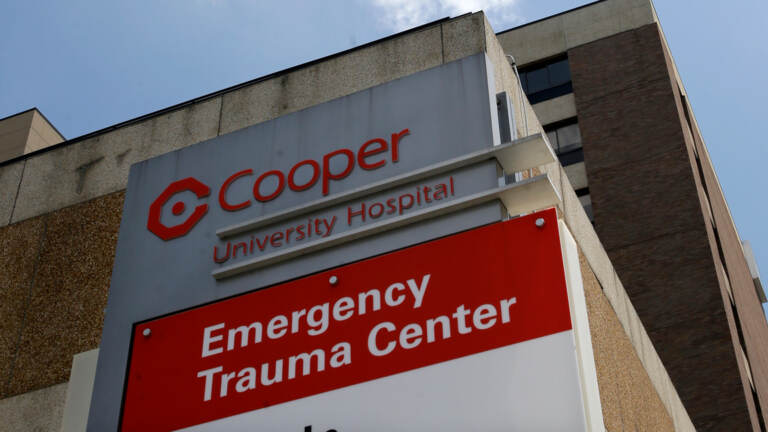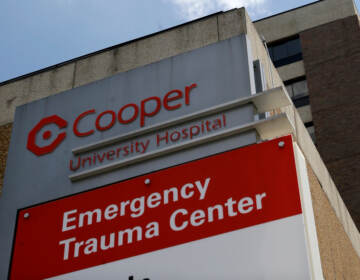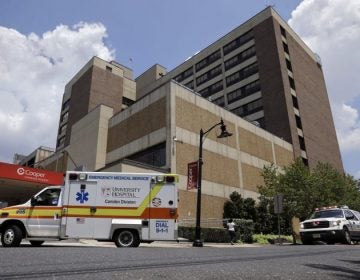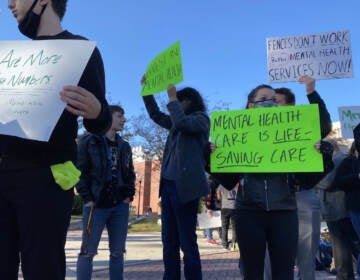After COVID, key hospitals get funding for next emergencies
NJ’s top trauma centers are laying out plans for the $550 million lawmakers sent them.

Cooper University Hospital trauma center, Camden. (AP Photo/Mel Evans)
At the height of the COVID-19 pandemic’s first wave, New Jersey’s three state-designated Level 1 trauma centers played a critical role, tracking and redistributing everything from masks to support staff to lifesaving ventilators. They coordinated supplies and information-sharing among regional hospitals that usually compete for patients and kept state officials informed as the virus spread from north to south.
“In a capitalist society we’re competitors, but when we’re in the middle of a crisis, we’re not,” said Mary Maples, interim president and CEO of Newark’s University Hospital, the Level 1 trauma center for the north, which cared for hundreds of COVID-19 patients at the peak. The way these facilities worked with acute-care facilities in their region “was a wonderful demonstration of the unity that we can show,” she added.
State lawmakers were also pleased with the role played by University Hospital and its counterparts in central and South Jersey, Robert Wood Johnson University Hospital in New Brunswick, and Cooper University Hospital in Camden. They added $450 million in federal COVID-19 relief funding to last year’s state budget to help ensure these sites are even better prepared for the next public health crisis. Now they want another $100 million for other hospital facilities.
Making plans
The news came as a happy surprise to hospital leaders. While no money has been spent yet, trauma center leaders have submitted plans to the state Department of Health for funding approval, according to budget documents filed as part of lawmakers’ review of Gov. Phil Murphy’s $49.9 billion spending proposal for the coming fiscal year, which starts in July. Each hospital has until the end of 2026 to spend their $150 million share.
At University, Maples said the investment will align with the hospital’s larger plan to rebuild some or all of the 500-bed, 43-year-old facility, a project that could cost $1 billion. “You can do the best with what you have at the time, but in an expanded and more modernly built facility we would have resources where more of our rooms could be flexible,” she said, singling out a new air-circulation system designed to reduce infection as one need. “I’m not talking about zippers and plastic sheeting, I’m talking about an actual system and you flip a switch.”
While the funding was initially limited to the three state-designated Level 1 centers — which handle the most critical victims of car crashes, gunshots and other traumatic incidents — the new spending proposal also calls for providing $100 million to Hackensack Meridian Health, the state’s largest health care system. Hackensack University Hospital, the system flagship, is also accredited as a Level 1 facility, but it is not designated by the state to take a regional leadership role.
Trauma centers — there are now 11 in New Jersey — can be accredited at levels 1 through 5, according to the American Trauma Society, but Level 1 facilities have more specialists and other resources. “A Level 1 Trauma Center is capable of providing total care for every aspect of injury — from prevention through rehabilitation,” the group notes.
The budget proposal for the fiscal year that begins in July also includes some $780 million in hospital funding, a mix of state and federal dollars that are delivered through various formulas to help offset the cost of treating uninsured patients, support medical education and incentivize quality improvements. State officials said the state’s 72 acute-care facilities have also benefited from some $2.2 billion in federal pandemic aid over the past two years.
Catastrophes to come
While legislative leaders provided no details when they added the trauma center funding to last year’s budget late in the process — it was not part of Murphy’s original plan — budget documents indicate it was aimed at helping them improve “their ability to respond to future health emergencies or catastrophic events.” Hospital leaders who gathered for a symposium at Rutgers University Thursday said that, as the pandemic recedes, they can now reflect on the past years and start to apply the lessons learned.
“Resilience is critical. We often talk about resilience in response to climate change,” said Stuart Shapiro, interim dean of Rutgers Edward J. Bloustein School of Planning and Public Policy, which hosted the symposium. “But the past two years of COVID-19 have also taught us that resilience very much applies to health care.”
Much of the trauma center funding is slated to support infrastructure upgrades, like expanding bed capacity, creating backup power and upgrading laboratory services. Cooper also hopes to invest in regional partnerships and health-equity efforts. Hackensack Meridian — which proposes to distribute its money among multiple facilities — would commit $5 million to scholarships at its medical schools and other training. Staffing shortages, the leaders agreed, remain a top challenge.
Hospital leaders from throughout the state stressed the importance of these community partnerships and how these collaborations became essential during the pandemic. Bill Arnold, the CEO of Robert Wood Johnson Hospital, told the group he worked with regional surgery centers — which were closed during the first peak — to borrow protective gowns, masks and gloves and recruit help for the hospitals from their out-of-work nursing staff.
“It was a good time during the crisis to think about your partners — and that may not necessarily be hospitals,” Arnold said.
Critical upgrades in the works
Robert Wood plans to improve power redundancy at its cancer center and enhance ventilation and medical-gas systems on the center’s surgical floor, triage area and decontamination center, according to budget documents. It also hopes to create a more “pandemic resilient” in-patient area and will contribute to laboratory upgrades at University Hospital. In all, the work will cost $180 million, with the hospital planning to kick in $30 million, reports note.
University intends to dedicate its $150 million to help with the redevelopment plan and upgrade the medical coordination center, a 24-7 service staffed by various emergency responders and clinical experts who coordinate the regional response to crises ranging from pandemics to hurricanes to terrorist attacks like 9/11. Money could also go to expand capacity in the emergency room or intensive-care department, budget documents show.
Cooper University plans to boost surge capacity by expanding into a building it owns next door, according to the budget files, and reduce infection risk by creating more single-bed rooms. It will also build a “state-of-the-art medical command center to strengthen regional planning and coordination,” documents note. Cooper officials declined to provide additional detail.
Getting ready for bio-wars
At Hackensack Meridian Health, leaders intend to use $65 million to add 73 beds at its flagship hospital in a unit with biocontainment capabilities, according to the budget files. Another $17 million would be used to enhance capacity at Palisades Medical Center’s emergency department, $8 million would fund a biosafety facility at the Center for Discovery and Innovation, a research hub, and $5 million would be used to expand a partnership with St. Joseph’s University Hospital, in Paterson. The remainder would pay for medical school scholarships and career training programs.
“The $100 million allocation for Hackensack University Medical Center will support the center’s efforts to strengthen regional health emergency preparedness infrastructure,” the system said in a statement, noting it was grateful to the governor and lawmakers for their “commitment to improving public health.”
WHYY is your source for fact-based, in-depth journalism and information. As a nonprofit organization, we rely on financial support from readers like you. Please give today.







